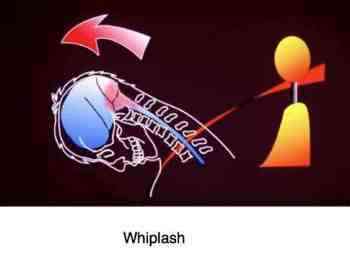- All You Need to Know
Soft-tissue injuries of the neck
Soft-tissue injuries of the neck cause severe lasting pain in 12% of those who suffered from a whiplash.

Soft-Tissue Injuries of the Neck - ligaments, muscles, fascia, nerves, the cord and dura, blood vessels - after whiplash injuries are still doubted by many. A prominent orthopaedic surgeon from Rotterdam recently likened a whiplash to a sprained ankle - where mostly there are no long term sequelae.
Gargan and Bannister reviewed the progress of 43 persons injured in car accidents (a rear-end collision), following them for 10 years[1].
Soft-Tissue Injuries of the Neck - ligaments, muscles, fascia, nerves, the cord and dura, blood vessels ... - after whiplash injuries are still doubted by many. A prominent orthopaedic surgeon from Rotterdam recently likened a whiplash to a sprained ankle - where mostly there are no long term sequelae. She is apparently unaware that the spinal cord transverses the neck.
Gargan and Bannister reviewed the progress of 43 persons injured in car accidents (a rear-end collision), following them for 10 years. Their conclusions were as follows:
- Only 12% were free of any discomfort and considered that they had made a complete recovery from their accident.
- 12% were still suffering from severe problems, had lost their jobs, relied continually on orthoses or analgesics, and had undergone repeated medical consultations.
- 28% were still experiencing intrusive symptoms which handicapped work and leisure and caused them to seek relief by frequent intermittent use of analgesia, orthoses or physiotherapy.
- 48% were left with mild symptoms which did not interfere with their work or leisure activities.
In short, after ten years, 60% had either recovered completely or had mild symptoms, but 40% were still still experiencing severe to intrusive symptoms, ten years after the accident.
Those symptoms included:
- Neck pain 74%
- Parasethesias 45%
- Lower back pain 42%
- Headache 42%
- Dizziness 19%
- Tinnitus and deafness 14%
- Dysphagia 2%
- Viusual symptoms
- Other significant findings
- Seat-belts afforded no protection in rear-end whiplash injuries.
- Patients with objective neurological signs and restriction of neck movement were more likely to experience continuing symptoms.
- 35% of those injured in motor vehicle collisions will experience delayed symptoms. Thus it is difficult to give a confident long-term prognosis for patients who have suffered soft-tissue injuries of the neck following a rear-end collision.
- Litigation does not appear to prolong symptoms.
Soft-tissue injuries of the neck
Soft-tissue injuries of the neck were surveyed 10 years after the whiplash yielding astonishing results.
- Home >
- Whiplash chiropractic >
- Soft-tissue injuries of the neck
Did you find this page useful? Then perhaps forward it to a suffering friend. Better still, Tweet or Face Book it.
